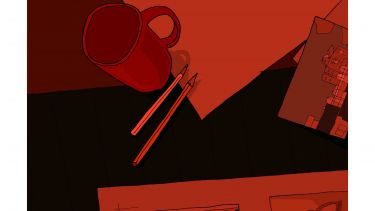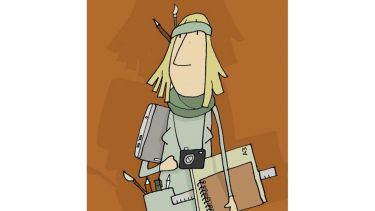Portfolio submission guidance: Structural Engineering and Architecture MEng
For applicants to Structural Engineering and Architecture MEng (HK21)

What is a portfolio?
People apply to the dual Structural Engineering and Architecture MEng course (HK21) with a variety of skills, and having studied a number of different subjects.
Since it is not always the case that applicants have studied Art at GCSE or A Level, we request a portfolio submission from all applicants as it gives us an important understanding of, not only your representational and creative skills, but also your critical thinking.
The portfolio should therefore be a selection of work that you think best demonstrates both your creative skills and the way you look at the world around you.
What we want made visible are your perceptions of the subject, your skill in interpreting it , and your manual dexterity and control of media in producing the representation.
Professor Peter Blundell-Jones
As you will not be present to explain your work, it is important that it is clear what it is about, and laid out in a manner that you feel best represents your approach. Work that demonstrates your ability to think in three dimensions and ability to use different media is encouraged.
You don’t have to do a lot of drawings of buildings at the expense of any other work. If you choose to represent buildings in your portfolio it may be useful to note why you have chosen a particular building or view of it.
If your strengths lie in a particular field, think of how you can use this in an innovative and appropriate way. What is vital is that the work submitted is all your own work.
What should your portfolio contain?
We ask that your portfolio contains six original pieces. Your work should be easy to look through and it should be clear what each piece is – remember that you will not be there to explain individual items to the people looking at your portfolio.
Text, neat labels, or a sheet of contents, for example, can all help to explain what you have produced.
As a further test of your critical, representational and observational skills, we ask that one of the six pieces of work you submit illustrates an aspect of the street/road/lane that you live on. This can be in any form and should be accompanied by a short text of 200 words.
We are interested in a creative, rather than strictly representational approach.
The best portfolios are those that show personal explorations, experiments and reflection, through a variety of techniques and types of work.
Dr. Christina Cerulli
Lecturer
For example, a straightforward sketch of the house opposite yours may show how well you can sketch, but not demonstrate an ability to look beyond what is immediately apparent.
You do not have to live in an area of particular architectural significance, in fact looking below the surface of (or in more detail at) what you consider to be an ‘ordinary street’ may create the most interesting pieces of work.
Similarly, the text accompanying your representational work should be imaginative, insightful and expressive - not purely descriptive.
Work suitable for inclusion as part of your portfolio may include:
- Drawing (ie pen/pencil/charcoal of objects/buildings/people etc)
- Painting (ie watercolour/oil/acrylic - figurative/abstract)
- Screen-printing
- Typography (ie font design, lettering layout)
- Graphic design (ie poster, magazine, flyer, book)
- Sculpture (ie small or large scale, wood/metal/plastic/clay etc)
- Ceramics (ie pottery, sculptural)
- Textile design (ie 2-D pattern design, creation of the fabrics themselves like weaving)
- Fashion design (design or making of clothing)
- Theatrical work (stage set design, lighting, costume (furniture, building)
- Product design (development sketches to finalised/built designs)
- Still photography (to highlight compositional skills and/or observational skills)
- Film (stills only, no video files)
- Jewellery (design or finished pieces)
- Collage (digital, paper, fabric, mixed media)
- Animation (stills only)
Submitting your portfolio
Since we ask that your portfolio is submitted digitally, you need to submit photos of three-dimensional work and photos or scans of two-dimensional work.
Ensure that:
- photographs are taken at a resolution that ensures that the file you submit is easy to see and is not distorted or blurred.
- if you are scanning a drawing, check that the resolution is set high enough and that the image isn’t too small.
We prefer you to combine all of your work into one file, allowing you to control the order that your work is seen in and to add a title page or contents page.
We are unable to review videos. If you wish to include them, please submit a selection of still images or a story board.
We accept the following file formats for combined files:
- Adobe Acrobat (.pdf)
- MS Word (.doc or .docx)
- MS PowerPoint (.ppt or .pptx)
We advise against submitting a collection of single image files (like jpegs) as this is time consuming to look through for staff who will have large volumes of portfolios to assess. If it is unavoidable, make sure to label files clearly, number them and provide a cover sheet or key.
We cannot accept archived files (ZIP, RAR etc), and you must ensure that - uncompressed - your chosen file type is no larger than 6MB.
Each file must be clearly labelled with your full name and with your UCAS ID or application number.
Replicating a specific art style (impressionism, cubism, pop etc), even with a great deal of skill, doesn’t demonstrate an ability to be creative. What I like is when I see that someone took these skills and made something else with them, shifted them to another meaning, or applied them in a different way. There must be a certain level of reflection that becomes apparent in the work.
Dr. Florian Kossak
Senior lecturer


